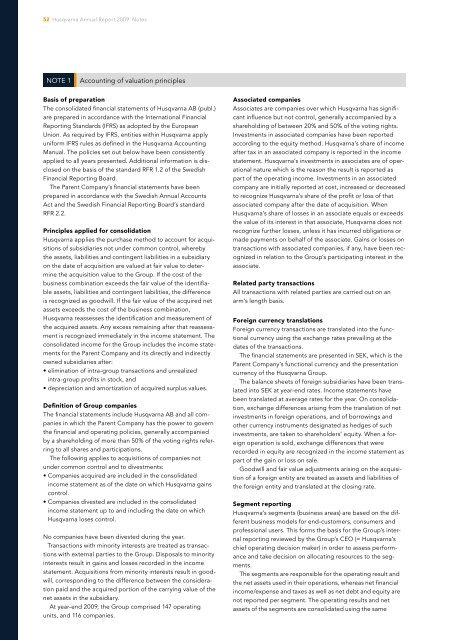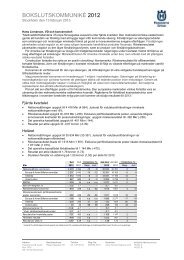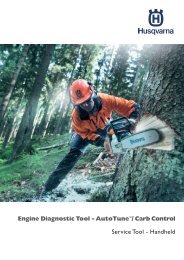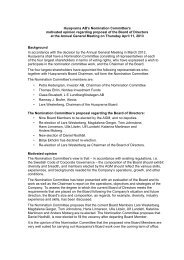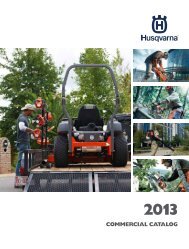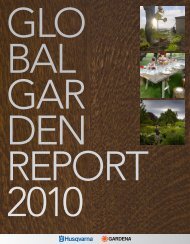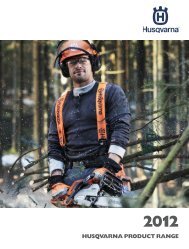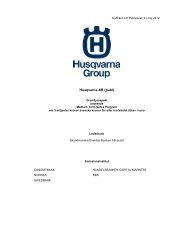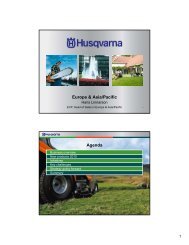Annual Report 2009 - Husqvarna Group
Annual Report 2009 - Husqvarna Group
Annual Report 2009 - Husqvarna Group
Create successful ePaper yourself
Turn your PDF publications into a flip-book with our unique Google optimized e-Paper software.
52 <strong>Husqvarna</strong> <strong>Annual</strong> <strong>Report</strong> <strong>2009</strong> Notes<br />
NOTE 1<br />
Accounting of valuation principles<br />
Basis of preparation<br />
The consolidated financial statements of <strong>Husqvarna</strong> AB (publ.)<br />
are prepared in accordance with the International Financial<br />
<strong>Report</strong>ing Standards (IFRS) as adopted by the European<br />
Union. As required by IFRS, entities within <strong>Husqvarna</strong> apply<br />
uniform IFRS rules as defined in the <strong>Husqvarna</strong> Accounting<br />
Manual. The policies set out below have been consistently<br />
applied to all years presented. Additional information is disclosed<br />
on the basis of the standard RFR 1.2 of the Swedish<br />
Financial <strong>Report</strong>ing Board.<br />
The Parent Company’s financial statements have been<br />
prepared in accordance with the Swedish <strong>Annual</strong> Accounts<br />
Act and the Swedish Financial <strong>Report</strong>ing Board’s standard<br />
RFR 2.2.<br />
Principles applied for consolidation<br />
<strong>Husqvarna</strong> applies the purchase method to account for acquisitions<br />
of subsidiaries not under common control, whereby<br />
the assets, liabilities and contingent liabilities in a subsidiary<br />
on the date of acquisition are valued at fair value to determine<br />
the acquisition value to the <strong>Group</strong>. If the cost of the<br />
business combination exceeds the fair value of the identifiable<br />
assets, liabilities and contingent liabilities, the difference<br />
is recognized as goodwill. If the fair value of the acquired net<br />
assets exceeds the cost of the business com bination,<br />
<strong>Husqvarna</strong> reassesses the identification and meas urement of<br />
the acquired assets. Any excess remaining after that reassessment<br />
is recognized immediately in the income statement. The<br />
consolidated income for the <strong>Group</strong> includes the income statements<br />
for the Parent Company and its directly and indirectly<br />
owned subsidiaries after:<br />
• elimination of intra-group transactions and unrealized<br />
intra-group profits in stock, and<br />
• depreciation and amortization of acquired surplus values.<br />
Definition of <strong>Group</strong> companies<br />
The financial statements include <strong>Husqvarna</strong> AB and all companies<br />
in which the Parent Company has the power to govern<br />
the financial and operating policies, generally accom panied<br />
by a shareholding of more than 50% of the voting rights referring<br />
to all shares and participations.<br />
The following applies to acquisitions of companies not<br />
under common control and to divestments:<br />
• Companies acquired are included in the consolidated<br />
income statement as of the date on which <strong>Husqvarna</strong> gains<br />
control.<br />
• Companies divested are included in the consolidated<br />
income statement up to and including the date on which<br />
<strong>Husqvarna</strong> loses control.<br />
No companies have been divested during the year.<br />
Transactions with minority interests are treated as transactions<br />
with external parties to the <strong>Group</strong>. Disposals to minority<br />
interests result in gains and losses recorded in the income<br />
statement. Acquisitions from minority interests result in goodwill,<br />
corresponding to the difference between the consideration<br />
paid and the acquired portion of the carrying value of the<br />
net assets in the subsidiary.<br />
At year-end <strong>2009</strong>, the <strong>Group</strong> comprised 147 operating<br />
units, and 116 companies.<br />
Associated companies<br />
Associates are companies over which <strong>Husqvarna</strong> has significant<br />
influence but not control, generally accompanied by a<br />
shareholding of between 20% and 50% of the voting rights.<br />
Investments in associated companies have been reported<br />
according to the equity method. <strong>Husqvarna</strong>’s share of income<br />
after tax in an associated company is reported in the income<br />
statement. <strong>Husqvarna</strong>’s investments in associates are of operational<br />
nature which is the reason the result is reported as<br />
part of the operating income. Investments in an associated<br />
company are initially reported at cost, increased or decreased<br />
to recognize <strong>Husqvarna</strong>’s share of the profit or loss of that<br />
associated company after the date of acquisition. When<br />
<strong>Husqvarna</strong>’s share of losses in an associate equals or exceeds<br />
the value of its interest in that associate, <strong>Husqvarna</strong> does not<br />
recognize further losses, unless it has incurred obligations or<br />
made payments on behalf of the associate. Gains or losses on<br />
transactions with associated companies, if any, have been recognized<br />
in relation to the <strong>Group</strong>’s participating interest in the<br />
associate.<br />
Related party transactions<br />
All transactions with related parties are carried out on an<br />
arm’s length basis.<br />
Foreign currency translations<br />
Foreign currency transactions are translated into the functional<br />
currency using the exchange rates prevailing at the<br />
dates of the transactions.<br />
The financial statements are presented in SEK, which is the<br />
Parent Company’s functional currency and the presentation<br />
currency of the <strong>Husqvarna</strong> <strong>Group</strong>.<br />
The balance sheets of foreign subsidiaries have been translated<br />
into SEK at year-end rates. Income statements have<br />
been translated at average rates for the year. On consolidation,<br />
exchange differences arising from the translation of net<br />
investments in foreign operations, and of borrowings and<br />
other currency instruments designated as hedges of such<br />
investments, are taken to shareholders’ equity. When a foreign<br />
operation is sold, exchange differences that were<br />
recorded in equity are recognized in the income statement as<br />
part of the gain or loss on sale.<br />
Goodwill and fair value adjustments arising on the acquisition<br />
of a foreign entity are treated as assets and liabilities of<br />
the foreign entity and translated at the closing rate.<br />
Segment reporting<br />
<strong>Husqvarna</strong>’s segments (business areas) are based on the different<br />
business models for end-customers, consumers and<br />
professional users. This forms the basis for the <strong>Group</strong>’s internal<br />
reporting reviewed by the <strong>Group</strong>’s CEO (= <strong>Husqvarna</strong>’s<br />
chief operating decision maker) in order to assess performance<br />
and take decision on allocating resources to the segments.<br />
The segments are responsible for the operating result and<br />
the net assets used in their operations, whereas net financial<br />
income/expense and taxes as well as net debt and equity are<br />
not reported per segment. The operating results and net<br />
assets of the segments are consolidated using the same


